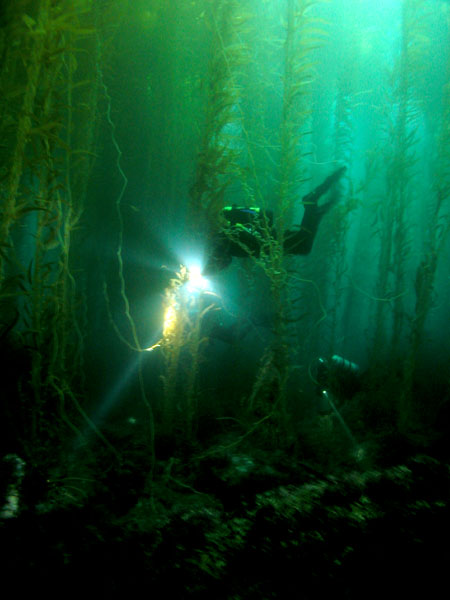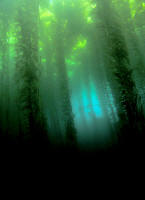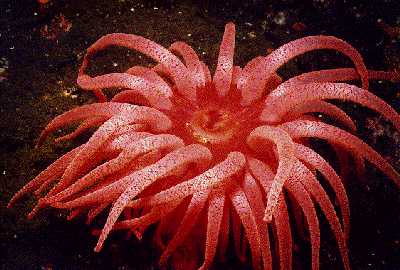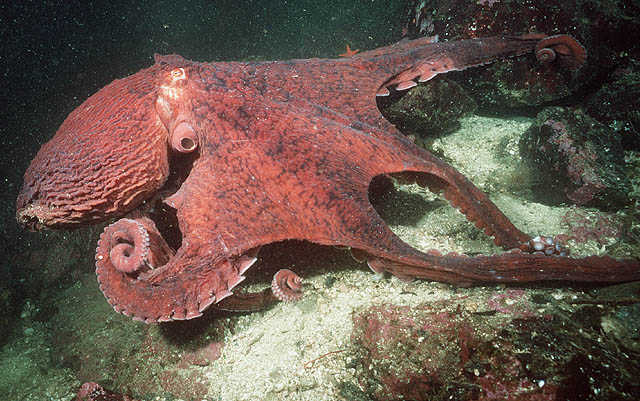Benthost
Benthos: organisms that live on the ocean bottom or within the sediments.
The benthos includes plants (in shallow water where there is enough light for plant growth), bacteria, and animals.
1. Intertidal Zonation
The distribution of plants and animals in the intertidal zone (as well as other areas of the sea bottom) is controlled by variations in the physical environment, by competition among organisms for scarce resources, and by predation on animals (or herbivory on plants).
Physical Environment includes the following:
- Light intensity and wavelength is important for seaweeds and other plants.
- Ultraviolet light can damage intertidal organisms when they are exposed at high tide.
- Air exposure is important for animals and plants in the high intertidal zone. They must be able to withstand or prevent desiccation. One strategy is to have a fairly watertight shell.
- Temperature varies relatively little in water, much more in air. High intertidal organisms must be able to withstand temperature variations.
- Salinity variations can be due to rainfall or to freshwater drainage across the intertidal.
- Wave energy can rip attached organisms away from surfaces, and subject all organisms to mechanical stresses and abrasion (by suspended sediment).
- Bottom type, hard or soft (rock and gravel, or sand and mud).
Competition for scarce resources, including:
- Food, a factor everywhere but especially so in the deep sea where little food is available.
- Space, a factor mainly in the intertidal and very shallow water, where often all surfaces are occupied by plants or animals.
Predation on animals and herbivory on plants:
- Animal defenses against predation include shells, accumulation of noxious chemicals (often present in plants consumed as food), and living in high intertidal habitats where most predators can’t tolerate the physical conditions.
- Plant defences against herbivory also include a high content of indigestible material (e.g., calcium carbonate in the case of coralline red algae), noxious chemicals, and locations with physical conditions that grazers can tolerate.
2. Benthic Plants
Benthic plant types:
- Single-celled algae that are similar to phytoplankton. In certain circumstances, phytoplankton themselves may grow on the bottom, also. (This sometimes happens following a bloom in shallow water.)
- These are found in shallow water where there is enough light for photosynthesis.
- They are found on any type of bottom, rock, sand, or mud.
 Macroalgae (seaweeds)
are multicellular plants that are related to the single-celled algae. Unlike most land
plants, they do not produce flowers or seeds, and they lack true leaves, stems, and roots.
Also unlike land plants, different parts of the seaweed do not have markedly different
types of cells with very different functions. Most of the cells in a seaweed are similar
to one another.
Macroalgae (seaweeds)
are multicellular plants that are related to the single-celled algae. Unlike most land
plants, they do not produce flowers or seeds, and they lack true leaves, stems, and roots.
Also unlike land plants, different parts of the seaweed do not have markedly different
types of cells with very different functions. Most of the cells in a seaweed are similar
to one another. - Grow only in shallow water (less than 200 m deep in most cases) where light is available for photosynthesis.
- Are more abundant in rocky intertidal zones and on rocky or gravel bottoms, since these provide anchors.
- Flowering plants that are very similar to land plants. These include eelgrass, turtle grass, cord grass (Spartina) and other sea grasses, and mangroves.
- Grow in shallow water, only (generally less than 1 m deep).
- Generally are restricted to water that is much less saline than average ocean water.
Seaweed types include green, brown, and red algae.
- These are named for their color, which is due to the accessory or extra pigments they have in addition to chlorophyll. (However, some species within these categories do not appear brown or red. Chlorophyll may mask the other pigments, so that they appear green, or they may have so much accessory pigment that they appear purple (reds) or almost black (browns).
- Because their pigments are better than chlorophyll for absorbing blue-green light, brown and red algae have more light energy available to them for photosynthesis in deeper water.
- Examples

Green: Sea lettuce (Ulva)
Dead man’s fingers (Codium)
Brown: Kelp (the largest seaweed)
Brown rockweed (Fucus)
Red: Corallina (found on coral reefs)
Porphyra
Seaweed parts:
- The holdfast anchors the plant to the bottom. It is not a root; it does not absorb water or nutrients as roots do.
- The stipe is the stem-like portion, but unlike true stems in land plants, it lacks specialized tissues for transporting water and nutrients.
- The blades are the leaf-like portions, but these too lack specialized transport tissues. These are not needed because the algae are immersed in water, and each cell has direct access to water, dissolved carbon dioxide, and dissolved nutrients. The blades of seaweeds are very thin to allow this direct access.
 Seaweed
importance:
Seaweed
importance:
- Seaweeds are major primary producers in many intertidal and shallow-water areas.
- Seaweeds provide shelter or sites for attachment for other algae and for a wide variety of animals.
Calcareous red algae help to build coral reefs and contribute to sediments and beach deposits.
3. Bacteria
As they are in the water column, bacteria are important decomposers of dead organic matter and recyclers of nutrients.
There are about 1 billion bacteria per each cubic centimeter of sediments.
4. Benthic Animals
Categories of benthic animals:
- Epifauna are animals that live on the surface of the ocean bottom. They live either on hard or soft bottoms.
- Soft bottoms consist of mud or sand.
- Hard bottoms consist of gravel, cobbles, or solid rock.
- Epifauna are usually filter feeders, surface grazers, scavengers, or predators.
- Infauna are animals that live in the bottom sediments. They can live only in soft bottoms.
- Infauna are often deposit feeders. Deposit feeders eat by ingesting the sediment, including large amounts of sand or mud, digesting the small proportion of organic material (1%-5%) and excreting the remainder. Infauna can also be predators or scavengers.
Major groups (phyla) of benthic animals:
Protozoans
- Single-celled, ameba-like animals related to the foraminifera and radiolarians and microflagellates of the zooplankton.
- Eat mainly bacteria (are bacteriovores) by engulfing the food to bring it within the cell.
Porifera (sponges)

- Very simple animals with no tissues or organs.
- Sponges are carnivores, filter feeders on (mainly) zooplankton.
- All adult sponges are sessile, that is, immobile and usually attached to a surface. Reproductive cells have flagella (can swim weakly) and are meroplankton.
Cnidaria (sea anemones and corals)
 The jellyfish of the
zooplankton is also a member of this phylum.
The jellyfish of the
zooplankton is also a member of this phylum. - The body of cnidarians has 3 layers: outer “skin”, jelly or mesoglea, and inner lining of the digestive cavity.
- All Cnidaria are radially symmetrical and have tentacles with stinging cells called nematocysts.
- Most Cnidarians are carnivores and predators that feed on zooplankton.
- Some (especially the corals) are filter feeders that trap particles (zooplankton and detritus) on their tentacles with mucous.
- Corals also get some of their nutrition from symbiotic algae, called zooxanthellae, within their bodies.
Mollusks (clams, mussels, oysters, snails, slugs, octopuses)
- Related to the pteropods of the zooplankton.
- Typically have a muscular “foot”, a calcium carbonate shell, and a feeding organ called a radula. They have highly-developed tissues and organs.
- Gastropods are the snails.
- They have a well-developed head, twisted body, spiral shell, and flat foot used for creeping.
- The nudibranchs, or naked snails, lack a shell and have straight bodies.
- Almost all feeding types are found in the gastropods, including filter feeders, predatory carnivores, herbivores, scavengers and deposit feeders.
- Bivalves are the clams, oysters, and mussels.
- Bivalve shells have two, equal parts, joined by a hinge.
- The head is indistinct.
- Most mussels and oysters are sessile, growing attached to surfaces.
- Clams use their foot for digging rather than creeping.
- Most bivalves are filter feeders that trap particles on enlarged gills. A few are deposit feeders.
- Cephalopods are the octopuses.
 Octopuses are closely
related to the squid and nautiluses of the nekton.
Octopuses are closely
related to the squid and nautiluses of the nekton. - Unlike other mollusks, they lack a shell.
- They have a well-developed head and nervous system, are are the most intelligent invertebrates.
- Their large, prehensile tentacles are for seizing prey. The tentacles are an evolutionary modification of the typical mollusk foot.
- All are carnivores and predators; some octopuses are scavengers, also.
Annelids are segmented worms, similar to earthworms.
- Annelid bodies are divided into a series of similar parts, but the head and tail sections do not have segments. Each segment has a pair of small appendages, with bristles (setae).
- They are round or oval in cross-section, not extremely thin and flat.
- Some annelids burrow through the mud (errant polychaetes) and are deposit feeders.
- Some annelids remain in tubes that they construct from secreted mucous that cements sediment particles together. These tube worms, such as the feather duster worm, are often filter feeders.
Arthropods include insects (rare in the ocean but common in lakes) and crustaceans (very numerous in the oceans).
- Arthropods have segmented bodies, outer shells of chitin, and jointed appendages.
- They have well-developed internal organs and complex nervous systems with large (for invertebrates) brains and elaborate sensory organs.
- Crustaceans are the major marine group of arthropods, including crabs, shrimps, lobsters, amphipods, and isopods.
- Crustaceans are related to the copepods and euphausiids of the plankton.
- They have 3 body parts, a head, thorax, and abdomen, two pair of antennae, and branched appendages (legs).
- The major groups include.
- Decapods (10 legs), the crabs, lobsters, and shrimp. Most are carnivores and predators, or scavengers.
- Isopods are oval, ca. 1 cm long, and flattened front to back, resembling pill bugs. Most are scavengers or deposit feeders.
- Amphipods are also about 1 cm long but are flattened side-to-side. They look shrimplike except that they usually have tiny eyes. Usually they are scavengers.
- Barnacles are sessile when adults, living within a shell shaped like a molar tooth that is attached to a surface. They are filter feeders on plankton and detritus particles in the water (omnivores).
Echinoderms include the sea stars (starfish), sea urchins, sand dollars, and sea cucumber.
- The larvae are bilaterally symmetrical, but the adults are radially symmetrical.
- The adults have a well-developed digestive tract, but other organ systems (e.g., reproductive, excretory, sensory, respiratory are relatively simple, compared with the arthropods, or absent.)
- All types have an internal or external skeleton of small ossicles, which sometimes fuse to form a solid shell (the sea urchins and sand dollars).
- A water-vascular system and tube feet for locomotion are also characteristic of this animal group.
- Types of echinoderms:
- Sea Stars (starfish)
generally have 5 arms (or a multiple of 5 arms). They are predators and carnivores, often
eating
 bivalve mollusks.
bivalve mollusks. - Brittle stars and basket stars have 5 thin arms, which are highly branched in the case of the basket stars. This group includes scavengers, deposit feeders or filter feeders (especially the basket stars).
- Sea urchins, heart urchins and sand dollars are round and spiny, although the spines are small in the sand dollars, and the ossicles are fused into a rigid shell. Sea urchins are usually herbivores that graze by scraping off algae that grow on hard surfaces. Heart urchins are deposit feeders. Sand dollars are deposit or filter feeders.
- Sea cucumbers are sausage or cucumber-shaped animals, with small ossicles and thus relatively soft squishy bodies. They are deposit or filter feeders.
- Sea lilies and feather stars are the most ancient group of echinoderms, existing more than 300 million years ago. They most often have 10 arms, but may have 5 to >100. The feather stars can swim via a sinuous motion of their arms. They are filter feeders.
Chordates include the fishes (already discussed) and the tunicates (such as sea squirts).
- Chordates characteristically have a dorsal (back) nerve chord, bilateral symmetry, and well-developed organs including sensory organs. However, the tunicates have some of these characteristics only as larvae. They are related to the larvaceans and salps of the zooplankton.
- As adults, tunicates are sessile, and lack a complete dorsal nerve cord and bilateral symmetry. They have a tunic or fibrous outer coating. They are often colonial (an assemblage of many individual organisms).
- Adult tunicates do have a digestive tract, heart and circulatory system, and reproductive organs. They have a rudimentary brain, but no sensory organs.
Adult tunicates are filter feeders (ciliary mucous feeders), omnivores that trap and consume particles in the water.
5. Benthos Summary
The kinds of plants and animals found in the intertidal zone or on/in the sea bottom are controlled by the physical environment, competition for scarce resources, and predation or herbivory.
The physical environment is highly variable in the intertidal, and often results in intertidal zonation, distinct plant and animal communities found in bands spanning narrow ranges of tidal height.
Competition for space is especially important in the intertidal, competition for food is crucial in most other areas of the sea floor. Predation is important in most areas, but is less in extreme environments like the high intertidal, and herbivory is important wherever plants can grow.
The kinds of plants and animals found in or on the bottom include:
- Bacteria :
- Plants:
- Vascular plants, only in brackish, shallow water.
- Seaweeds
- Green, red, and brown algae.
- Microalgae
- Most types found among the plankton, particularly diatoms.
- Animals:
- Protozoans like foraminiferans.
- Sponges.
- Cnidarians like sea anemones and corals.
- Annelids like the feather-duster worm.
- Crustaceans like crabs and amphipods.
- Mollusks like clams, snails, and octopuses.
- Echinoderms like sea stars, sea urchins, and sea cucumbers.
- Chordates like tunicates and fish.
Epifauna live on the bottom surface. They are often filter feeders or surface grazers. They are found on hard or soft bottoms.
Infauna live in the sediment of sandy and muddy bottoms. They are often deposit feeders, but also can be filter feeders. They are found in soft bottoms.
The major feeding strategies of benthos are:
- Filter feeding
- Deposit feeding
- Surface grazing
- Scavenging
Predation
